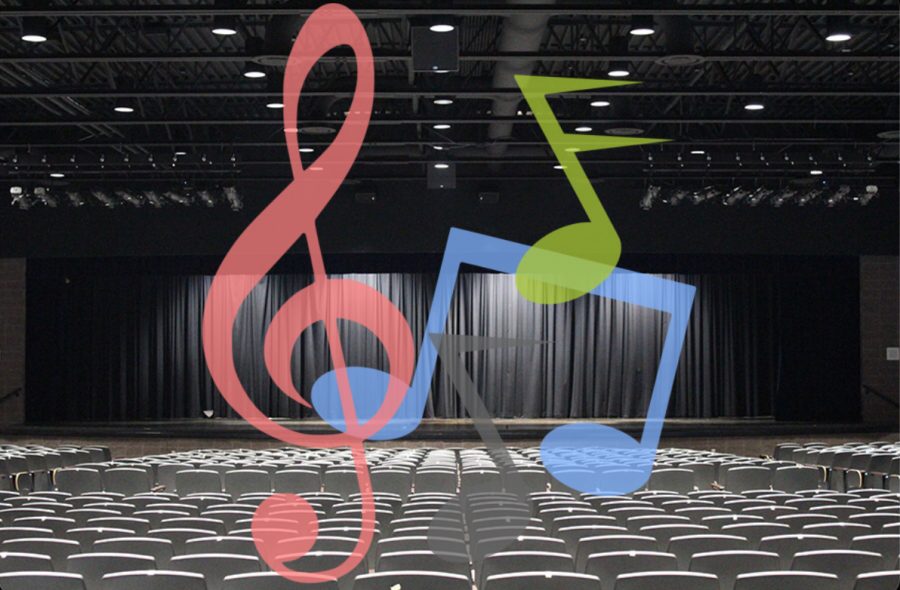Student leadership holds key to the arts
The arts are often compared for their similarities and differences, but the one thing all of them have in common is student leaders. These select students balance being a regular student and an example for their peers.
When people talk about student leadership opportunities they often think of the sports that have “team captains” or people who serve on the “leadership team.” But the arts also have a spotlight on the students that serve their community and their personal art.
Students that participate in the arts have the unique opportunity to better their own skills, and performances, lead their peers and help them better their own individual performances to better the performance as a whole. All the different types of performative arts have their own ways of letting students take the lead.
“We have section leaders that sit at the front of the section. They are some of the top musicians so they have to be able to do that,” orchestra teacher Nathan Kufchak said. “This year [senior] Jodie Stone is our Concert Mistress. She is kind of the figurehead of the whole orchestra. She kind of runs rehearsals if I’m not there and can do all that stuff.”
The role of section leaders is to polish the individual groups of instruments, parts, or voices. They are a common leadership position in the band, orchestra, chorus, and even theatre.
While the orchestra students rehearse with their student section leaders, the drama students are led by dance captains in shows, technical student leaders such as stage managers, and student choreographers in cirque and dance numbers.
“I have found, in my very short teaching, that people tend to listen better, or they feel more comfortable communicating about issues within the department to their peers,” theatre director Lauren Kuykendall said. “So for me, it keeps morale better, and it keeps me in check because I find a lot of the time people are scared to talk to me about issues or ideas to me directly.”
Leadership roles in theatre that include decision making and being the “face” of the department are the officers in the Thespian Society. One student in theatre took this local position and went statewide with it. Junior Aleena Soto now serves as a 2022-2023 State Thespian Officer which means she is in charge of planning the state conference, volunteer opportunities, and the planning of next year’s schedule.
“It’s very difficult because a lot of people have a lot of different opinions, and you want to try to please everyone,” Soto said. “Sometimes it’s hard, and because you are friends with everyone you are working with, it’s even harder because you don’t want to upset anyone or cause any arguments.”
These problems are not just for theatre students. All types of student leaders deal with the difficulty of managing the friendships of the people they are leading. Orchestra Mistress Jodie Stone says she struggles with the same problems.
“You have to figure out the dynamic between being a leader in the program and being a friend, because I’m friends with a lot of kids in the orchestra,” Stone said. “But I have to figure out when I can be like ‘we need to do this’ versus when I can just hang out.”
Student leaders can struggle with making choices that affect an entire group of people, but they also get to make fun decisions that benefit a whole group. Student choreographers get to create different dances and movements that showcase an entire group of amazing people. The Starr’s Mill choral department’s spring showcase highlights some of these students.
Senior Olivia Price is this year’s head choreographer for Chanticleer’s, the men’s and women’s combined chorus, portion of the spring show. She is tasked with creating and teaching the dances along with her co-choreographers.
“It’s a lot of work, every day we have got to choreograph a new song. We are all done now, which is good,” Price said. “So we are just cleaning and making sure everything is sharp and facials are very important.”
Band students also have peers to look up to, including band captain senior Ella Stadelmeyer. She oversees the section leaders and manages internal issues in the band.
“I was band captain and I would basically help people through their issues, and be their friend, and lead as an example in the band instead of forcing them to do things,” Stadelmeyer said.
Last year was a weird time for all art students. Restrictions were high and the time to rehearse was different than before. Stadelmeyer also experienced this in the shift between this year and last.
“It was a lot different with COVID. There was not as much to do,” Stadelmeyer said. “This year was a big change, a lot to deal with, but it ended up working out.”
One thing that everyone seems to say is that they feel that student leaders in the arts are underappreciated. It takes a lot of people to put together a concert or show, and these leaders are vital to them.
“There are so many moving parts to the arts, as opposed to an academic class. And certainly, there can be many parts to an academic class, but say math or biology, it’s just one expert teaching others, a teacher-student relationship,” choral director Dr. John Odom said. “But in the arts, there’s so many moving parts. A very important and integral part of being successful in the arts is student leadership. It’s hard to function without it.”


